- The term periglacial (near-glacial) literally means around the ice or peripheral to the margins of the glaciers but now this term is used for both ‘periglacial landscape’ and ‘periglacial climate’.
- Periglacial areas are those which are in permanently (perennially) frozen condition but without permanent ice cover on the ground surface.
- The periglacial climate is characterized by mean annual temperature ranging between 1°C and – 15°C and mean annual precipitation of 120 mm to 1400 mm (mostly in solid form).
- Periglacial landform is a feature resulting from the action of intense frost, often combined with the presence of permafrost. Periglacial landforms are restricted to areas that experience cold but essentially nonglacial climates.
- Periglacial regions are very active geomorphological areas. The Mechanical splitting of rocks by ice (gelifraction), frost heaving of the ground (geliturbation), solifluction and nivation are all important processes. In addition, each spring, large quantities of water from melting snow and ice rapidly erode the debris scattered and moved down the slopes. Wind action is also a significant force.
- In 1950 L.C Peltier put forward the concept of a periglacial cycle of erosion. This is similar to the Davisian concept of the normal cycle of erosion, and the periglacial landscape attains old age after passing through the stages of youth and maturity.
- During this entire period there is erosion of the higher parts and deposition in low-lying parts, resulting in overall reduction in relief, and the slope profile gradually becomes smooth and flat. The process by which there is gradual flattering of the surface in the periglacial regions is called ‘cryoplanation’.
- In this process there is parallel retreat of the scarp face by frost shattering and the development and gradual extension of gentle slope at its base by deposition and transport of debris.
- Cryoplanation is thus achieved primarily by the processes of intense frost action or congelifraction and solifluction or congeliturbation. The penultimate landform is a surface of low local relief, not controlled by any base level, and has been called a ‘cryoplain‘ or an ‘altiplain‘.
- The present-day periglacial zones are found in the Arctic regions of Alaska, Canada, Greenland, and Siberia and also in Antarctica, and the fossil zones of Pleistocene, and other past Ice Ages.
- Permafrost and the active layer are the two most striking features of periglacial areas.
- Permafrost is a condition where a layer of soil, sediment, or rock below the ground surface remains frozen for a period greater than a year (for at least 2 years). Permafrost is not a necessary condition for creating periglacial landforms. However, many periglacial regions are underlain by permafrost and it influences geomorphic processes acting in this region of the world.
- Permafrost is found in about 25 percent of the Earth’s non-glaciated land surface. It occurs wherever the mean annual ground temperature is less than 0° Celsius. Common depths of permafrost are several hundred meters. Most deposits of permafrost have an upper active layer that is between 1 to 3 meters thick. This active layer is subject to a cyclic thaw during the summer season.
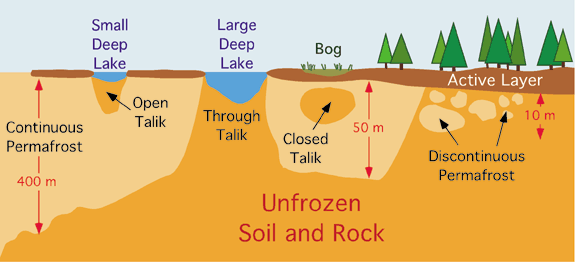
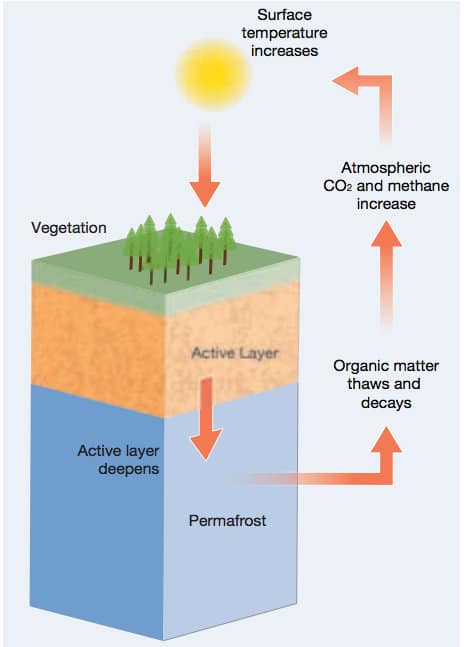
Key terms
- Permafrost – Permanently frozen ground where soil temperatures have remained below 0 °C for at least 2 years
- Continuous Permafrost – Summers so cold that there is only a very superficial surface melting of the ground. It has been estimated to reach up to a depth of 1500 metres. Mean annual air temperatures of below -5 °C all year, and as low as -50 °C.
- Discontinuous Permafrost – Found is slightly warmer areas so there are islands of permanently frozen ground separated by small pockets of unfrozen less cold areas. Slightly warmer zones due to proximity of surface water (rivers, lakes, and the sea). Mean annual temps of between -1 °C and -5 °C
- Sporadic Permafrost – Found when mean annual temperature is just below 0ºC and the summer temperatures reach several degrees above but isolated pockets of permanently frozen ground remain below the surface.
- Active Layer – summer temperatures sufficient to melt the surface layer of permafrost. This layer can be very mobile. It varies in thickness depending on latitude and vegetation cover.
- Talik – Any unfrozen material within the permafrost zone.
Evolution of the Periglacial Erosion Cycle
The evolution of the periglacial erosion cycles its different stages have been as:
- Stage 1 (Initial surface)
- The cycle begins with the onset of periglacial conditions. In this initial stage congelifraction is especially active as a result of which there is shattering of the bare rocks on the upper slopes, and block fields are formed by the accumulation of angular rock fragments.
- Stage 2 (Early or young stage)
- The rock fragments move downhill along the slope by gravity, and talus or congeliturbate mantled slope is formed at the base of the slope.
- During this period nivation hollows, as well as cryoplanation terraces, also begin to be formed on the higher slopes.
- Till the end of the young stage, the scarp of the terraces starts retreating by frost action, and the terrace benches are extended by scarp retreat.
- Stage 3 (Mature Stage)
- With further passage of time, the scarps are destroyed by continual recession and in their place only residual or for features are left on the summits or slopes.
- This is the beginning of maturity when the original landscape is lost and the valleys and lower slopes are covered with a mantle of frost shattered and soliflucted materials.
- Stage 4 (Old Stage of cryoplanation)
- Towards the end of maturity and in old age, the higher land is further reduced and levelled on account of solifluction, and the accumulation of debris goes on increasing in the neighbouring valleys and low-lying lands, and the periglacial surface is converted into an almost level plain.
- The debris becomes fine on account of continual frost weathering and solifluction (gelifluction) by further disintegration and abrasion.
- The finer debris is transported by the wind, and loess and sand dunes are formed at places, and areas of ventifacts and lag deposits develop by the blowing away of finer materials by the wind.

Taking the different slope forms found in periglacial regions as the basis, Peltier has tried to synthesize them and arrange them in a sequence. His hypothesis thus provides an overall framework for the understanding of the slope evolution in periglacial regions, but it does not provide an analysis of how exactly slope form is influenced by frost shattering and solifluction. Further, adequate attention has not been paid to other processes, especially the influence of running water.
But the concept of scarp recession by frost shattering and the resultant extension of the terraces is by itself an important and useful concept that helps us to understand the formation of cryoplanation terraces, summit tors, nivation hollows & cryopedimerts.
Periglacial Landforms – Erosional
Freeze-Thaw Cycle
- Freeze-thaw weathering is a process of erosion that happens in cold areas where ice forms. A crack in a rock can fill with water which then freezes as the temperature drops. As the ice expands, it pushes the crack apart, making it larger. When the temperature rises again, the ice melts, and the water fills the newer parts of the crack. The water freezes again as the temperature falls, and the expansion of the ice causes further expansion to the crack. This process continues until the rock breaks.

Nivation Hollow
- Hollows produced by snow-patch erosion or nivation are called nivation hollows which are generally found along the hillsides in various forms. They extend from a few metres to 1.5 kilometres.
- In time, these hollows may trap more snow and may deepen further with more nivation so that cirques or thermocirques are formed.
- They are classified on the basis of shape into: (i) Transverse hollows (ii) Longitudinal hollows.
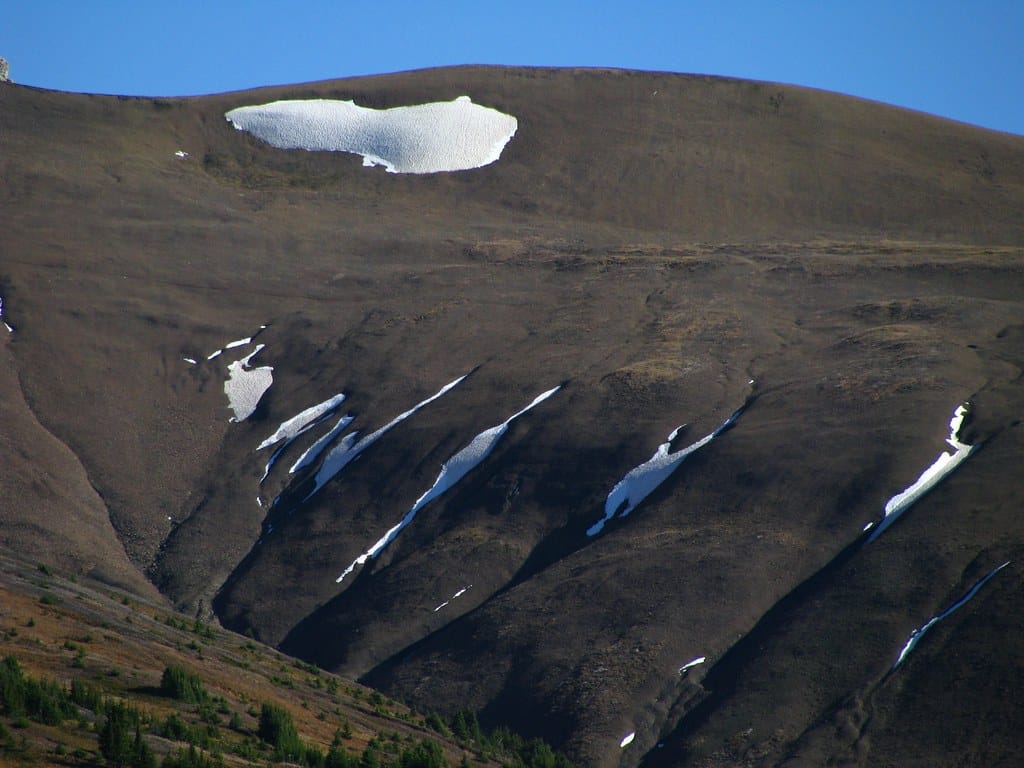
Asymmetrical Valley
- An asymmetric valley is a valley that has steeper slopes on one side. Valley has one side steeper than the other, the opposing slopes having significantly contrasting angles.
- This contrast may be caused by geologic structure or variation in the nature and intensity of erosional (e.g. periglacial) processes and there may be contrasts in the vegetation on the opposing slopes.
- Such valleys are common in past and present periglacial environments, where aspect has a significant effect on the nature of frost-based processes and on the depth of the active layer.
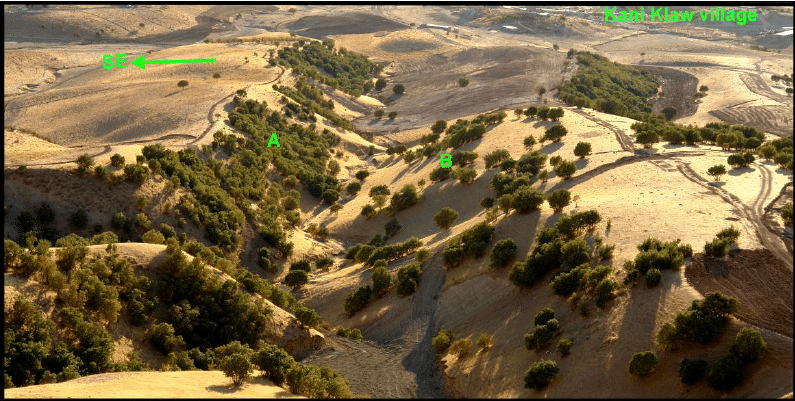
Cryoplanation Terraces or Goletz Terraces
- Cryoplanation terraces (also known as altiplanation or goletz terraces and by several other terms) are periglacial landforms consisting of nearly horizontal bedrock surfaces or benches backed by frost-weathered bedrock cliffs.
- Cryoplanation Terraces (CTs) are erosional landforms reminiscent of giant staircases, with alternating shallow sloping treads and steep scarps leading to extensive flat summits.
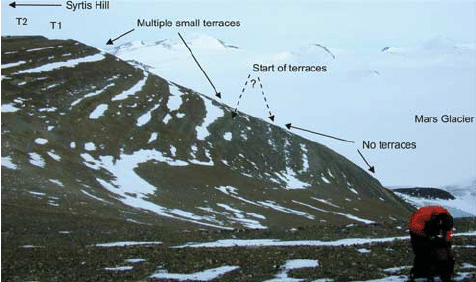
Patterned Ground
- When Ice from below makes upward pressure the overlying sedimendary flat rocks are being weathered and cracks are developed, these cracks it seems are having some pattern on ground.
- A process called frost heaving is responsible for these features.
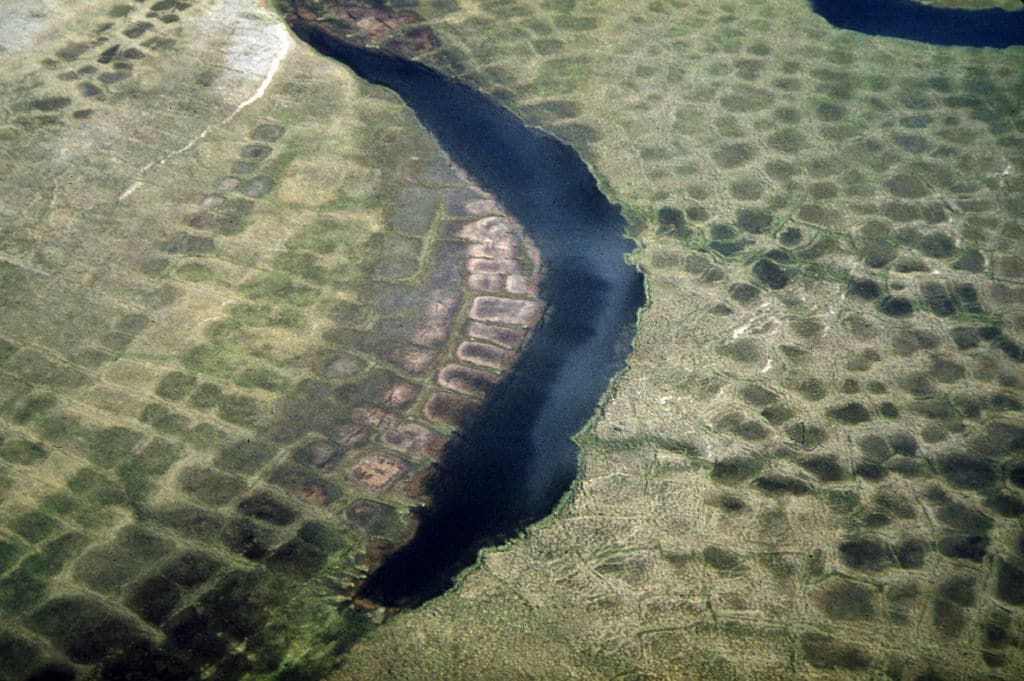
Frost Crack Polygon
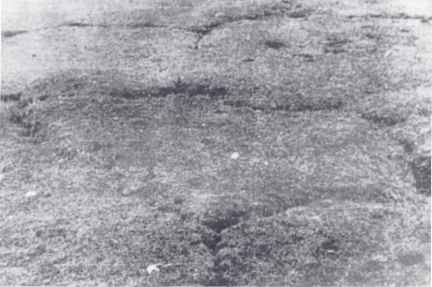
Stone Strips
- A stone stripe is an elongated concentration of mostly talus-like basalt rock found along a hillside or the base of a cliff. Many stone stripes occur without cliffs.
- Stone stripes are thought to have been originally created by periglacial conditions of the Quaternary period during an Ice age. It is likely their formation originates from multiple processes including frost action, surface erosion, eluviation, and mass wasting. However, it is likely that intense freeze and thaw cycles account for the natural sorting of the rock debris within a stone stripe, and also accounts for the shallow depth of the stripes, since frost penetration is thought to not penetrate deeper than 1 meter in the region.
- A stone stripe is identified by its lack of vegetative cover.
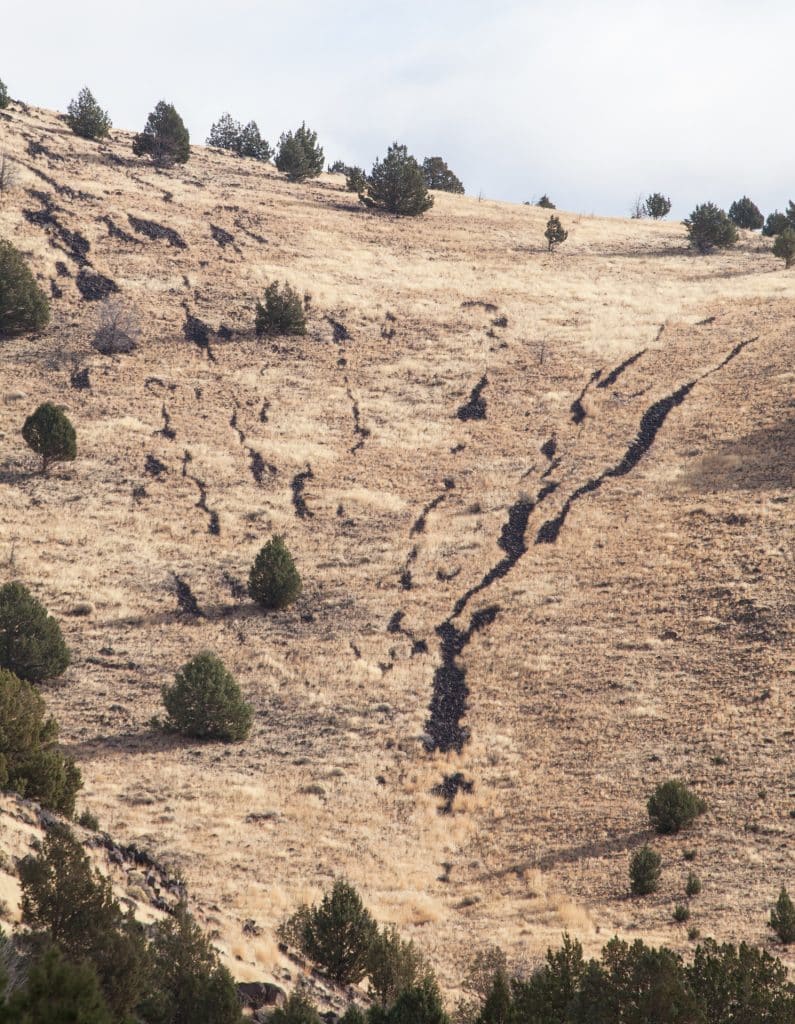
Pingo
- Pingo is an Eskimo word that means isolated dome-like low mounds or hills found in permafrost areas. This word was first used by A.E. Porsild in the year 1938. They are found in continuous as well as discontinuous permafrost areas.
- They are abundantly found in the arctic areas (65° N ) of Canada, Alaska, Greenland and Siberia.
- They range in height from a few metres to 60 metres (sometimes they are as high as 100 metres) and from a few metres to 300 metres in diameter. Small pingos have closed tops whereas big pingos have open tops.
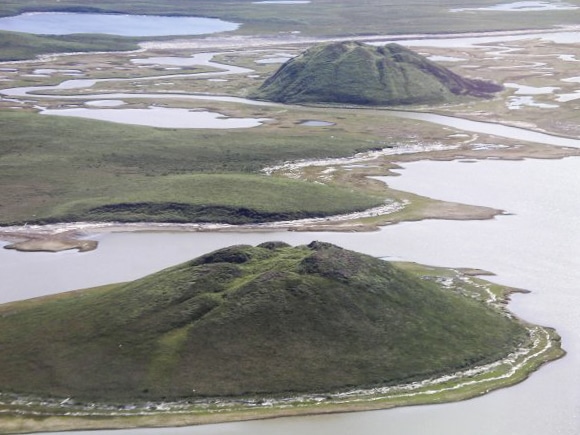
Hummocks
- Small upstanding wrinkles on the surface of permafrost are called hummocks. These are formed due to squeezing of the ground surface because of lateral pressure exerted by freezing of active layer.
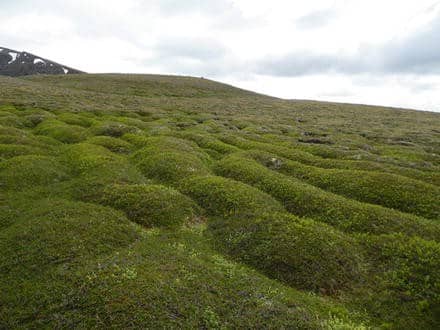
Palsa
- A special category of hummock found in swampy areas and composed of peats having thin ice layers inside is called palsa which is about 10m in height and 10 to 20 m in diameter and is mostly found in the periglacial environment of arctic and subarctic areas.
- Palsa may be destroyed by rise in water table in the nearby swamps or by fracture in its upper surface.
- It is formed by frost heaving under the influence of ice segregation.
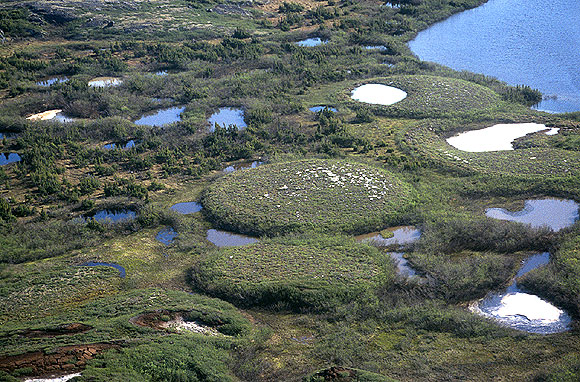
Periglacial Landforms – Depositional
BlockFields or Felsenmeer
- Blockfields are areas covered by large angular blocks, traditionally believed to have been created by freeze-thaw action.
- Block field refers to the natural collection of large stone blocks at the flat surface of the hill tops in the periglacial areas. These block fields are also called blockmeer and falsenmeer. The stone blocks are formed due to frost weathering (congelifraction).

Patterned Ground
- Blockfields sometimes takes some geometrical shapes (like circles, polygons, nets, stripes and garlands) and are so systematically arranged are called Patterned Ground.
- Patterned Ground is erosional as well as depositional landforms in periglacial.
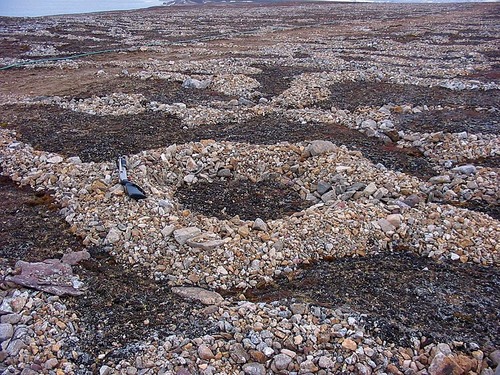
Tors
- Tors, one of the most controversial landforms, are piles of broken and exposed masses of hard rocks having a crown of rock blocks of different sizes on the top and clitters (trains of blocks) on the sides. The rock blocks, main components of tors, may be cuboidal, rounded, angular, elongated etc. in shape.
- They may be seated at the top of the hills, on the flanks of the hills or on flat basal platforms ranging from 6 m to 30 m in height. They are found in different climates varying from cold to hot and dry to humid. Though tors have developed over almost all types of rocks but they are frequently found in the regions of granites.
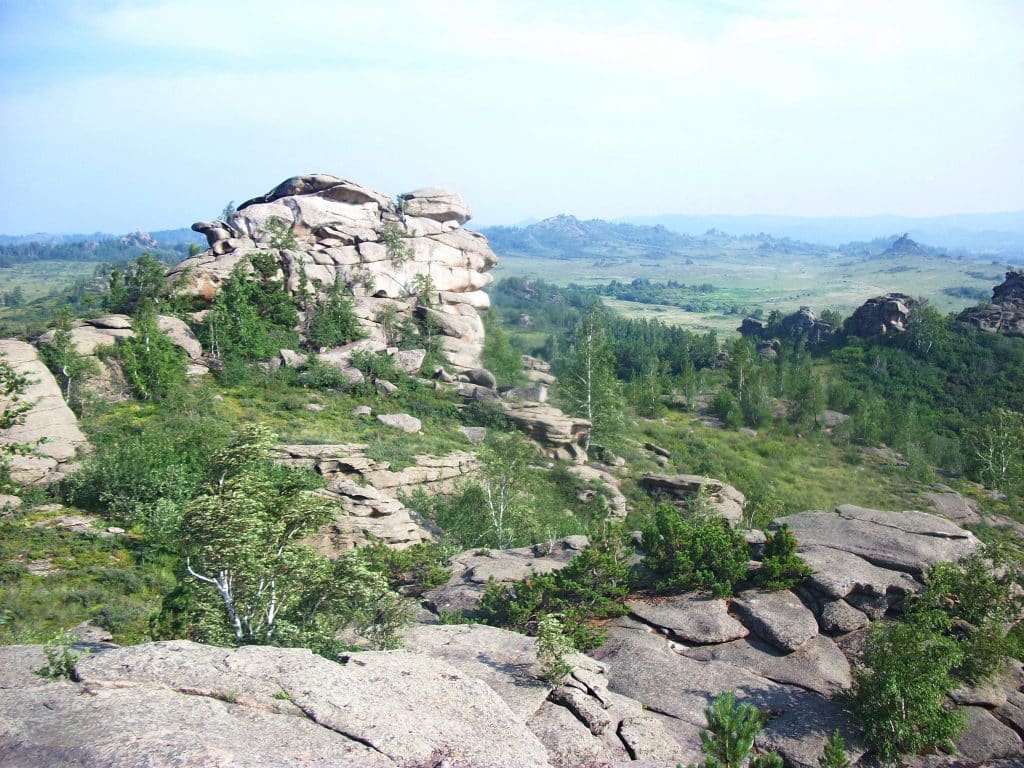
Boulder Fields
- Boulder Field is a periglacial feature that formed as a direct result of its proximity to the end moraine. Accumulations of rock debris in the valley floors are called stone streams or boulder fields.
- The stone is well sorting of rock debris in the stone streams. The upper layer consists of large and coarse debris while the lower layer is dominated by fine materials. Water channel is developed between the valley walls and stone stream. Sorting of rock debris occurs through the process of frost Heaving. Stone streams move downslope due to the force of gravity, frost heaving and solifluction.
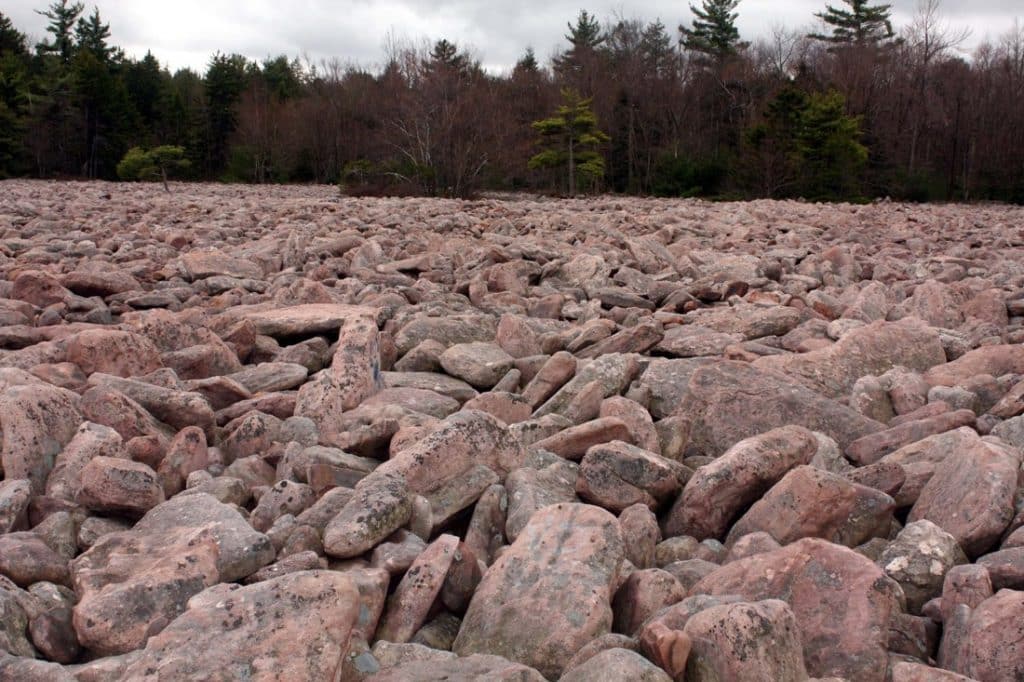

Proper classification is needed.
Beautifully explained and this topic is otherwise not available easily on net
This is best platform for geography optional thank you so much to provide notes very very useful